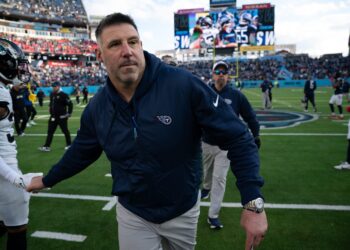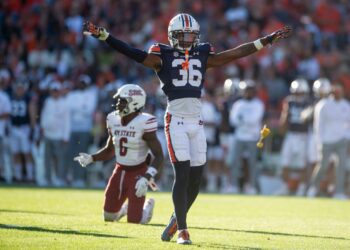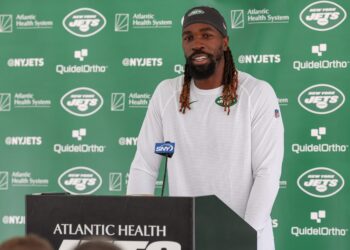The Rookie Wage System – Part Two: Positives and Potential Problems
This is part two of Jet-Nation’s articles on the improved rookie wage system under the NFL’s new Collective Bargaining Agreement (CBA) which took effect in 2011. (Click here to view part-one)
There was a problem in the NFL with the structure of rookie contracts even before the new CBA was being negotiated. Teams were often forced to give an exorbitant amount of guaranteed money to unproven rookies resulting in years of financial damage if the player turned out to be a bust.
The best/worst example of this was the contract (6 years, $61 million, $32 million guaranteed) the Oakland Raiders signed with 2007 number one overall draft pick quarterback JaMarcus Russell. After holding out into the 2007 season Russell then treated the Raiders to 25 starts over three years with 18 touchdowns, 23 interceptions, a completion percentage of 52 and quarterback rating of 65. The Raiders finally released Russell in May 2010.
There was a rookie wage system in place in 2007 the problem was too many ways to circumvent it. Agents would add escalators, advances and bonuses along with extended holdouts if the player’s demands were not met. Often teams folded, like the Raiders, and entered into risky contracts. Teams had no choice but to keep giving these high priced players more opportunities since releasing them would result in a huge salary cap hit. So failing players continued with a team, which is supposed to get an advantage by drafting early, ends up in a situation where they cannot win.
As discussed in part one the rookie salary guidelines are strictly set in the new CBA. Most first round rookie contracts are now fully guaranteed since they are make less than in the past but 2011 first overall pick Cam Newton’s contract (4 years, $22 million) even fully guaranteed is $10 million less than Russell’s guaranteed money was in 2007. Any amount of guaranteed money in a player’s contract accelerates onto the current year’s salary cap, maybe broken up over two years, if he is released so lower guarantees means less salary cap damage if a player doesn’t work out.
Rookie holdouts have now become nonexistent since there is little to negotiate. There are some precedents which were set last year and seem to be continuing. Draft picks 1-16 are receiving all four years of their contracts guaranteed while 17-32 are getting about 3-3.5 years guaranteed. For example number 17 pick Dre Kirkpatrick received a four year $8.6 million contract with $7.84 guaranteed, while number 19 pick Shea McClellin got $8.2 million with $7.5 guaranteed.
Another positive of the improved system, teams are more willing to trade up into top draft spots where before they’d be scared off by the potentially huge financial commitment. This year saw many trades in the top ten of the draft including the Saint Louis Rams trading back from number two acquiring picks from the Washington Redskins who wanted to select quarterback Robert Griffin III. This is a real win-win for both teams the Redskins get what they see as a franchise quarterback and the Rams get more picks to help their rebuilding process. Under the old system this trade may never have happen but teams now know the financial risk of signing a high draft choice is much less and worth making deals.
The CBA requires all drafted players to receive a four year contract but teams hold a fifth year option with first round picks. The teams can exercise this option after the end of the players third season adding an additional year to the original contract. The salary is figured like this: A player picked 1-10 receive the average salary of the top ten players at his position while picks 11-32 get the average salary of the top three through twenty five players at his position. The salary is determined at that time the option is exercised after the players third season entering their fourth. The fifth year salary is guaranteed for injury only until the start of the players “Fifth League” year where it becomes fully guaranteed.
Rounds three-seven are provided an opportunity to receive an escalator to their fourth year salary. If a player is involved in 35% of plays for two out of his first three years or 35% cumulative for all three years combined he’ll receive an increase in the fourth year’s salary. The increase will be whatever amount “tender”, a salary offer made by a team, a restricted free agent at the “right of first refusal” level receives. This is the lowest tender a team can give, $1.26 million in 2012, and the team has the right to match an offer made to one of their restricted free agents. If a player hits the play percentage incentives his fourth year base salary will rise to the above mentioned tender amount, whatever that is at the end of their third year.
The NFL and the player association seemed to try and eliminate draft picks from becoming restricted free agents by forcing four year contracts. After four years a player would become an unrestricted free agent but here’s the potential problem with the system as it moves forward. The CBA allows for drafted rookie contracts to be renegotiated after the player’s third season and the new contract no longer falls under the CBA’s rookie salary limitations. It seems that a player who is out performing his contract would want a new one after year three but the team has control at least four or five years, if they have the first round option.
Let’s look at two examples of problems which may arise from this year’s Jets draft class:
First round pick Quinton Coples is going to make approximately $1.5 million base salary in 2015. If the Jets exercise their team option under the CBA Coples would receive an estimated $9 million base salary in 2016. That is $5.25 million average for 2015-16. If Coples turns out to be an above average pass rusher during the first three seasons he’d be worth a lot more than $5 million per year. Coples would want to renegotiate after year three getting the security of a long term deal and would not want to risk injury or decreased play for two more years preventing a potential big payday.
Third round pick Demario Davis 2015 base salary is estimated at about $800,000. So if he were to hit the escalator his salary would rise to the “first refusal” tender, estimated at $1.5 million in 2015. If Davis is playing at a high level he’d be worth much more on the open market then $1.5 million. Under the old system Davis could have signed a three year contract which would make him a restricted free agent in 2015. The Jets would most likely tender him at a first round level, any team who signed him would forfeit their first round pick to the Jets, to protect Davis from being taken by another team. That tender would be about $3 million so Davis could play under that offer for one year and then become an unrestricted free agent or try and work out a long term contract. Basically Davis would rather renegotiate after year three than take the escalated salary the CBA offers.
While there is no perfect system the rookie salary terms under the CBA seems to set up a struggle between the players and teams after the third year of a rookie contract. The player may have no choice but to use the only thing they can to get a new deal, holdout. Since NFL contracts will never be 100% guaranteed there is always going to be some player unhappy with their contract who holdsout but it’ll be interesting to see if teams renegotiate after three years or stand firm trying to keep the player under their rookie contract for however long the CBA allows.
Videos
Jets Leaks Could Have Massive Implications on 2025 Season









